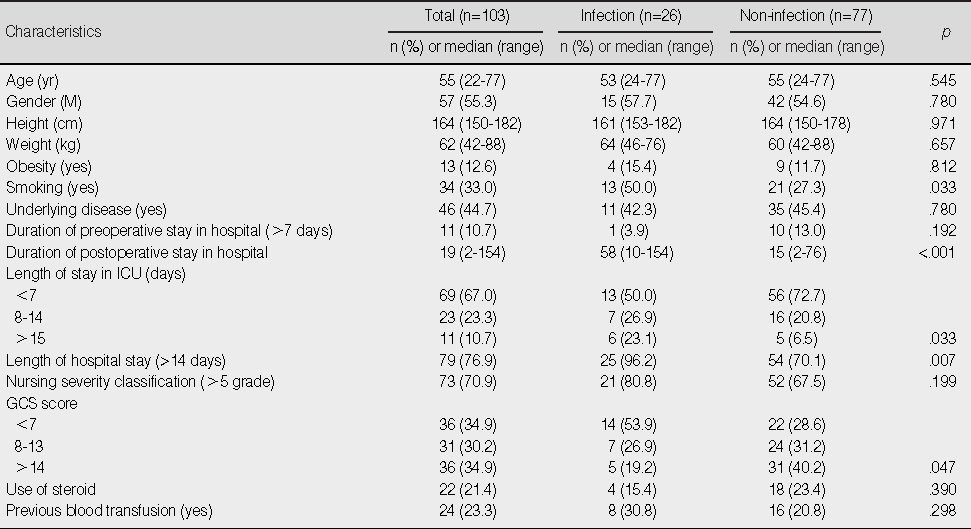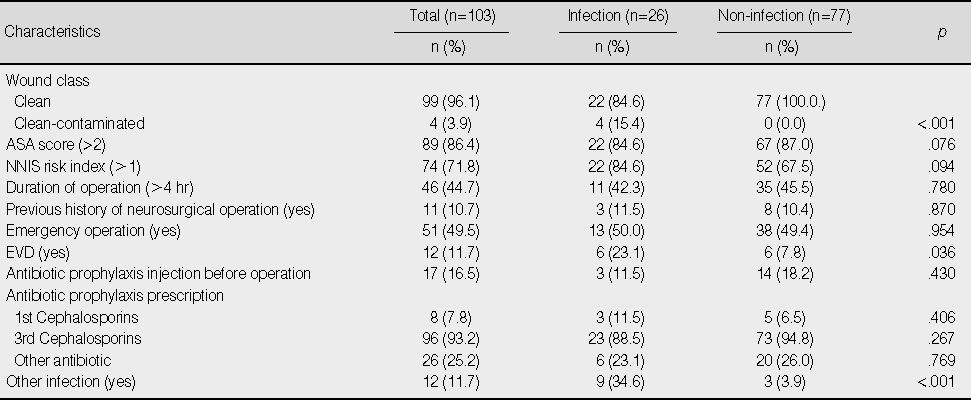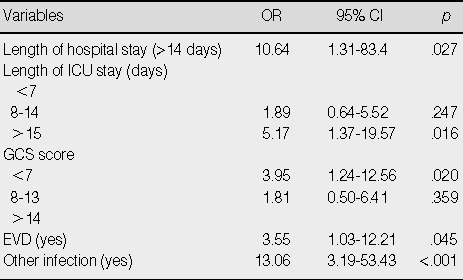Articles
- Page Path
- HOME > J Korean Acad Nurs > Volume 40(2); 2010 > Article
-
Original Article
- Risk Factors for Surgical Site Infections in Patients Undergoing Craniotomy
- Kyeong-Sook Cha, Ok-Hee Cho, So-Yeon Yoo
-
Journal of Korean Academy of Nursing 2010;40(2):298-305.
DOI: https://doi.org/10.4040/jkan.2010.40.2.298
Published online: April 30, 2010
1Registered Nurse, Department of Infection Control, St. Vincent's Hospital, Suwon, Korea.
2Full-time Lecturer, Department of Nursing, Hyechon University, Daejeon, Korea.
3Unit Manager, Department of Infection Control, St. Vincent's Hospital, Suwon, Korea
- Address reprint requests to: Yoo, So-Yeon. Department of Infection Control, St. Vincent's Hospital, 93-6 Ji-dong, Paldal-gu, Suwon 442-723, Korea. Tel: 82-31-249-7858, Fax: 82-31-249-7838, icpyou@hanmail.net
Copyright © 2010 Korean Society of Nursing Science
Abstract
-
Purpose
- The objectives of this study were to determine the prevalence, incidence, and risk factors for postoperative surgical site infections (SSIs) after craniotomy.
-
Methods
- This study was a retrospective case-control study of 103 patients who had craniotomies between March 2007 and December 2008. A retrospective review of prospectively collected databases of consecutive patients who underwent craniotomy was done. SSIs were defined by using the Centers for Disease Control criteria. Twenty-six cases (infection) and 77 controls (no infection) were matched for age, gender and time of surgery. Descriptive analysis, t-test, χ2-test and logistic regression analyses were used for data analysis.
-
Results
- The statistical difference between cases and controls was significant for hospital length of stay (>14 days), intensive care unit stay more than 15 days, Glasgrow Coma Scale (GCS) score (≤7 days), extra-ventricular drainage and coexistent infection. Risk factors were identified by logistic regression and included hospital length of stay of more than 14 days (odds ratio [OR]=23.39, 95% confidence interval [CI]=2.53-216.11) and GCS score (≤7 scores) (OR=4.71, 95% CI=1.64-13.50).
-
Conclusion
- The results of this study show that patients are at high risk for infection when they have a low level of consciousness or their length hospital stay is long term. Nurses have to take an active and continuous approach to infection control to help with patients having these risk factors.
- 1. Ahn YJ, Sohng KY. Factors related to surgical site infections in patients undergoing general surgery. Journal of Korean Academy of Fundamentals Nursing. 2005;12:113–120.
- 2. Bruce JN, Bruce SS. Preservation of bone flaps in patients with postcraniotomy infections. Journal of Neurosurgery. 2003;98:1203–1207.ArticlePubMed
- 3. Cho YA, Shin HJ, Cho JK, Jung MK, Lee BN, Song KJ. Development and application of the workload management system for critical care nurses (WMSCN) using WMSN. Clinical Nursing Research. 2005;11:71–84.
- 4. Choi HJ, Park JY, Jung SY, Park YS, Cho YK, Park SY, et al. Multi-center surgical site infection surveillance study about prosthetic joint replacement surgery in 2006. Korean Journal of Nosocomial Infection Control. 2008;13:42–50.
- 5. Choi YH, Park ES, Chang KH, Yeom JS, Song YG, Chang BC, et al. Surgical site infection rates according to patient risk index after cardiovascular surgery. Korean Journal of Nosocomial Infection Control. 1998;3:11–22.
- 6. Culver DH, Horan TC, Gaynes RP, Martone WJ, Jarvis WR, Emori TG, et al. Surgical wound infection rates by wound class, operative procedure, and patient risk index. National nosocomial infections surveillance system. The American journal of medicine. 1991;91:152S–157S.PubMed
- 7. Garner JS, Jarvis WR, Emori TG, Horan TC, Hughes JM. CDC definitions for nosocomial infection, 1988. American Journal of Infection Control. 1988;16:128–140.ArticlePubMed
- 8. Garner JS, Jarvis WR, Emori TG, Horan TC, Hughes JM. APIC Infection Control and Applied Epidemiology: Principles and Practice. 1996;St. Louis, MO, Mosby.
- 9. Haley RW, Culver DH, Morgan WM, White JW, Emori TG, Hooton TM. Identifying patients at high risk of surgical wound infection. A simple multivariate index of patient susceptibility and wound contamination. American journal of epidemiology. 1985;121:206–215.PubMed
- 10. Hwang JH, Choi YG, Sung JK, Hwang SK, Hamm IS, Park YM, et al. Intracranial infection in head injury. Journal of Korean Neurosurgical Society. 1995;24:337–382.
- 11. Jeong YI, Mun SP, Chang JH, Kim KC, Min YD, Kim SH, et al. The risk factors associated with surgical site infection after an abdominal operation. Journal of the Korean Surgical Society. 2008;75:177–183.
- 12. Kim JM, Park ES, Jeong JS, Kim KM, Kim JM, Oh HS, et al. 1997 National nosocomial infection surveillance in Korea. Korean Journal of Nosocomial Infection Control. 1997;2:157–176.
- 13. Kim KS, Kwon EO, Kim MA, Park OH, Song KJ, Song LY, et al. Clinical care nursing in ICU. 2004;Seoul, Koonja Publishing.
- 14. Korean Association of Infection Control Nursing. KAICN Text of Infection Control. 2006;Seoul, Dong-Bang Han Publishing.
- 15. Korean Society for Nosocomial Infection Control. Management of nosocomial infection. 2006;3rd ed. Seoul, Han-Mi Medical Publishing.
- 16. Korinek AM, Golmard JL, Elcheick A, Bismuth R, van Effenterre R, Coriat P, et al. Risk factors for neurosurgical site infections after craniotomy: A critical reappraisal of antibiotic prophylaxis on 4,578 patients. British Journal of Neurosurgery. 2005;19:155–162.ArticlePubMed
- 17. Kourbeti IS, Jacobs AV, Koslow M, Karabetsos D, Holzman RS. Risk factors associated with postcraniotomy meningitis. Neurosurgery. 2007;60:317–325.ArticlePubMedPDF
- 18. Lee JH, Han HS, Min SG, Lee HG, Lee JH, Kim YU, et al. Surveillance of surgical wound infections among patients from the department of surgery: Prospective trial. Journal of the Korean Surgical Society. 2004;66:133–137.
- 19. Lee SY, Kim SD, Lee JS, Lee KH. Risk factors for surgical site infection among patients in a general hospital. Korean Journal of Nosocomial Infection Control. 2007;12:9–20.
- 20. Lietard C, Thébaud V, Besson G, Lejeune B. Risk factors for neurosurgical site infections: An 18-month prospective survey. Journal of Neurosurgery. 2008;109:729–734.ArticlePubMed
- 21. Mangram AJ, Horan TC, Pearson ML, Silver LC, Jarvis WR. Guideline for prevention of surgical site infection, 1999. Centers for Disease Control and Prevention (CDC) hospital infection control practices advisory committee. American Journal of Infection Control. 1999;27:97–132.PubMed
- 22. Martone WJ, Gaynes RP, Horan TC, Danzig L, Emori TG, Monnet D, et al. National Nosocomial Infections Surveillance (NNIS) semiannual report, may 1995. A report from the National Nosocomial Infections Surveillance (NNIS) System. American Journal of Infection Control. 1995;23:377–385.ArticlePubMed
- 23. Mayhall CG. Hospital Epidemiology and Infection Control. 2004;3rd ed. Philadelphia, PA, Lipnincott Williams & Wilkins.
- 24. Oh HS. The epidemiology of post-operative wound infection and it's effects on the hospital stay and the cost of hospitalization. 1993;Seoul, Seoul National University. Unpublished master's thesis.
- 25. Park ES, Kim KS, Lee WJ, Jang SY, Choi JY, Kim JM. The economical impacts of surgical site infections. Korean Journal of Nosocomial Infection Control. 2005;10:57–64.
- 26. Park JH, Yoon HS. A study of hospital infection in the postoperative patients. Journal of Korean Academy of Nursing. 1986;16:70–76.ArticlePDF
- 27. Reichert CF, Medeiros AS, Ferraz AP. Hospital-acquired meningitis in patients undergoing craniotomy: Incidence, evolution, and risk factor. American Journal of Infection Control. 2002;30:158–164.ArticlePubMed
- 28. Teasdale G, Jennett B. Assessment of coma and impaired consciousness. A practical scale. Lancet. 1974;13:81–84.
- 29. Yu SM, Jeon SS, Kang IS, An HG. Status of nosocomial urinary tract infections in the ICU: Molecular epidemiology of imipenem resistant P. aeruginosa. Journal of Korean Academy of Nursing. 2006;36:1204–1214.ArticlePubMedPDF
REFERENCES
Figure & Data
REFERENCES
Citations

- An update on a persisting challenge: A systematic review and meta-analysis of the risk factors for surgical site infection post craniotomy
Francesco Magni, Aws Al-Omari, Robert Vardanyan, Arian A. Rad, Susan Honeyman, Alexandros Boukas
American Journal of Infection Control.2024; 52(6): 650. CrossRef - RETRACTED: Comprehensive analysis of risk factors and pathogenetic characteristics associated with surgical site infections following craniotomy procedures
Zhiwei Gu, Chuanjian Tu, Dagang Song, Zhihao Yang, Jiajie Xia
International Wound Journal.2024;[Epub] CrossRef - RETRACTED: A meta‐analysis of the risk factors for neurosurgical surgical site infection following craniotomy
Dechao Sun, Zhuang Ma, Yadong Geng, Chenxu Kong, Zhenjiang Li
International Wound Journal.2024;[Epub] CrossRef - Validation of the Risk Prediction Tool for Wound Infection in Abdominal Surgery Patients
Hyun Kyoung Jung, Eun Nam Lee
Journal of Korean Critical Care Nursing.2022; 15(3): 75. CrossRef - Association between registered nurse staffing levels and in-hospital mortality in craniotomy patients using Korean National Health Insurance data
Yunmi Kim, Se Young Kim, Kyounga Lee
BMC Nursing.2020;[Epub] CrossRef - Logistic Regression Analysis of Risk Factors for Intracranial Infection After Multiple Traumatic Craniotomy and Preventive Measures
Jing Yao, Dong Liu
Journal of Craniofacial Surgery.2019; 30(7): 1946. CrossRef - Risk factors of neurosurgical site infection after craniotomy: A systematic review and meta-analysis
Chenyan Fang, Tao Zhu, Ping Zhang, Liang Xia, Caixing Sun
American Journal of Infection Control.2017; 45(11): e123. CrossRef - Infecciones del sistema nervioso central en pacientes críticos con lesión cerebral, con y sin antecedente de manejo neuroquirúrgico
José D. Charry, Fabio Antonio García, Natalia Johana Ortega, Johanna Osorio
Acta Colombiana de Cuidado Intensivo.2015; 15(1): 9. CrossRef - Recent Advances in the Patient Safety and Quality Initiatives Movement
Isaac Yang, Nolan Ung, Daniel T. Nagasawa, Panayiotis Pelargos, Winward Choy, Lawrance K. Chung, Kim Thill, Neil A. Martin, Nasim Afsar-Manesh, Brittany Voth
Neurosurgery Clinics of North America.2015; 26(2): 301. CrossRef - Knowledge, Practice, and Associated Factors towards Prevention of Surgical Site Infection among Nurses Working in Amhara Regional State Referral Hospitals, Northwest Ethiopia
Freahiywot Aklew Teshager, Eshetu Haileselassie Engeda, Workie Zemene Worku
Surgery Research and Practice.2015; 2015: 1. CrossRef - Post-operative central nervous system infections after cranial surgery in China: incidence, causative agents, and risk factors in 1,470 patients
R. Zhan, Y. Zhu, Y. Shen, J. Shen, Y. Tong, H. Yu, L. Wen
European Journal of Clinical Microbiology & Infectious Diseases.2014; 33(5): 861. CrossRef - Risk Factors for Surgical Site Infections According to Electronic Medical Records Data
Young Hee Kim, Young-Hee Yom
Journal of Korean Academy of Fundamentals of Nursing.2014; 21(2): 151. CrossRef - Etiología de las infecciones quirúrgicas en pacientes sometidos a craneotomía
Elena Múñez, Antonio Ramos, Teresa Álvarez de Espejo, Josep Vaqué, José Sánchez-Payá, Vicente Pastor, Ángel Asensio
Neurocirugía.2012; 23(2): 54. CrossRef
General Characteristics of the Patients
ICU=intensive care unit; GCS=glasgow coma scale.
Comparison of Surgical Site Infections Associated Variables between Infection and Non-infection Group
ASA=American society of anesthesiologists; NNIS risk index=national nosocomial infection surveillance risk index; EVD=extra-ventricular drainage.
Predictors of Surgical Site Infections using Univariate Analysis
OR=odds ratio; CI=confidence interval; GCS=glasgow coma scale; EVD=extra-ventricular drainage.
Predictors of Surgical Site Infections using Stepwise Logistic Regression
OR=odds ratio; CI=confidence interval; GCS=glasgow coma scale; EVD=extra-ventricular drainage.
ICU=intensive care unit; GCS=glasgow coma scale.
ASA=American society of anesthesiologists; NNIS risk index=national nosocomial infection surveillance risk index; EVD=extra-ventricular drainage.
OR=odds ratio; CI=confidence interval; GCS=glasgow coma scale; EVD=extra-ventricular drainage.
OR=odds ratio; CI=confidence interval; GCS=glasgow coma scale; EVD=extra-ventricular drainage.
 KSNS
KSNS
 E-SUBMISSION
E-SUBMISSION




 Cite
Cite

